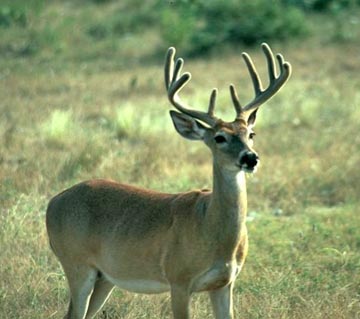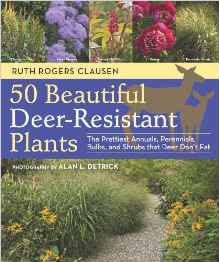Is Bambi in Your Garden?
By George Graine, Fairfax Master Gardener
Dealing with these garden marauders requires a varied strategy and vigilance
— Carole Ottesen

White-tailed deer
The author begins with a primer on deer: telltale signs of deer traffic, with precautions to take before serious damage occurs, and seasonal patterns of high deer activity. She describes commonly used controls such as physical barriers (e.g., fencing and netting of various heights and types) and commercially available deer repellents and home remedies. Some tips on designing a deer-resistant garden follow:
- Select plants that deer avoid
- Use plant barriers such as tall, dense shrubs
- Change the terrain
- Try cultural techniques
Unfortunately for gardeners, the problem has become more acute as the deer population continues to grow. The numbers keep increasing because the deer’s only “predator” in our urban area is the automobile — and cars barely make a dent (pardon the pun) in their burgeoning population.
 Practically no plant is immune from a hungry deer, especially during a harsh winter when available food is limited. The key to keeping your garden reasonably safe is to plant unappetizing plants. This does not prevent deer from nibbling (read, tasting) some plants when they would prefer to eat something else. The background material at the beginning of this book will give you a better grasp of how to cope with the deer problem. It will help you understand deer behavior and the variety of methods gardeners can use to deter the deer.
Practically no plant is immune from a hungry deer, especially during a harsh winter when available food is limited. The key to keeping your garden reasonably safe is to plant unappetizing plants. This does not prevent deer from nibbling (read, tasting) some plants when they would prefer to eat something else. The background material at the beginning of this book will give you a better grasp of how to cope with the deer problem. It will help you understand deer behavior and the variety of methods gardeners can use to deter the deer.
Discussion of the 50 plants follows this introductory material. The book is arranged alphabetically by plant type (e.g., annuals, perennials). Its full-color photos of each plant could double as calendar art. A tight editorial approach is used, providing a quick look at each plant’s hardiness zone, height, and spread and a deer-resistance rating on a scale of 7 to 10. Why only 7 to 10? Because plants rated lower than 7 and regularly browsed by deer are not included in the book. The ranking system cleverly differentiates the plants whose buds and flowers are eaten by deer from those plants whose foliage the deer generally leave alone. In addition to these basics, the book includes expanded information on how to grow the plant. It also gives the reader design tips for that specific plant and companion plants. Helpful sidebar notes for each plant add to the book’s appeal.
Like it or not, deer are here to stay. This book will help you cope with them.